Not Dumbed-Down Tips for Your Pollinator Garden – #1 Lacy Phacelia
May 18, 2020
Everywhere you look, there’s talk of gardening for pollinators. The piece in Fine Gardening promotes plants from its sponsored nursery as being the best for bees, the city of Eugene’s public works rag gives some tips as it’s cover piece, and nurseries have new signage touting the pollinator friendly plants on display.
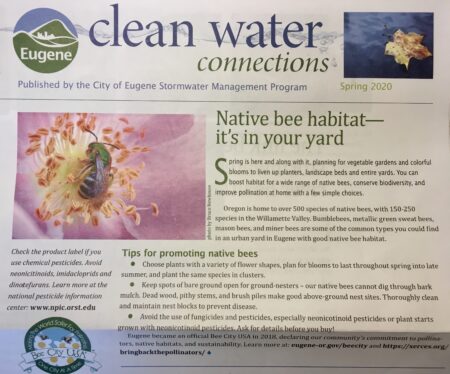
Cool trend, necessary trend. We need pollinators and they’re having a rough time.
I have to comment about how vague and dumbed-down some of this advice is, though. Like “choose plants with a variety of flower shapes.” That could mean anything! You might go for a fully double flowering rose bush and think their flower shape is helping native bees. You’d be wrong, but it’s not your fault. They do have a unique shape. One that’s been bred to be beautiful, but that’s coincidentally hard for a bee to navigate with all those extra petals getting in the way. They’re fun to stuff your nose into, remind you of dear grandma and are gorgeous in a vase.
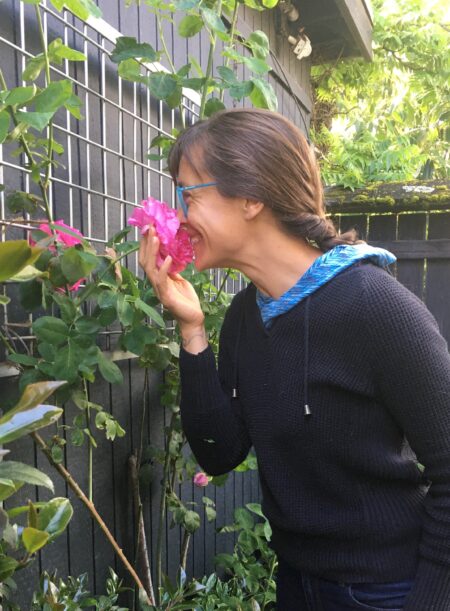
But, you’ll want to combine it with other plants like this nearly wild ‘Corylus’ rose if you’re thinking “I want to help bees.”
Included in tips for pollinator gardening is often the guidance to avoid pesticides. Um, isn’t that obvious? I hope I’m not being naive, but if you’re thinking about planting to help out pollinating insects, aren’t you already aware of how pesticides mess up the cycle of life? I’d rather see a mention about the lesser known insect armageddon caused by leaf blowers.
I’ll throw my hat into the ring on this trending topic, because it does matter. However, I hope to offer you very specific ideas you can use to make a real difference and have fun while gardening for bees, hummingbirds, butterflies and all of nature’s beautiful, buzzing flower visitors. With this in mind, I’m launching a series of bite-sized articles with clear take aways that you can use to effect positive change in your garden.
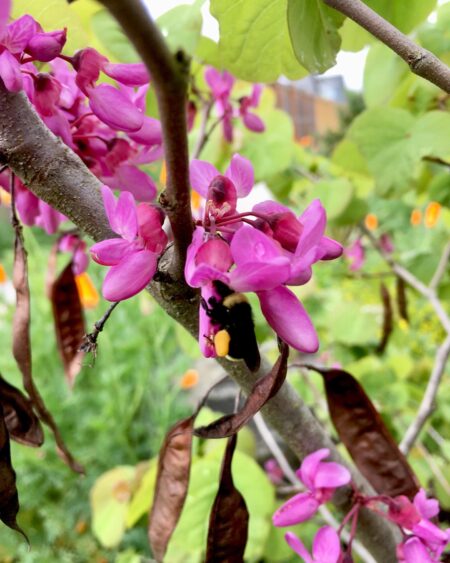
Western redbud is a bumblebee buffet
Your first tip in this not dumbed-down pollinator gardening series is an inexpensive idea that easily layers into your existing garden.
Let me introduce you to lacy phacelia (Phacelia tanacetifolia). Such a beautiful flower to behold in the spring, once you see it, you’re sure to be smitten. Even more enamored, though are the numerous species of bees that find its pollen load irresistible. It’s also a hover fly favorite. Did you know that those guys eat aphids? Yes! Lacy phacelia is a champ on all fronts.
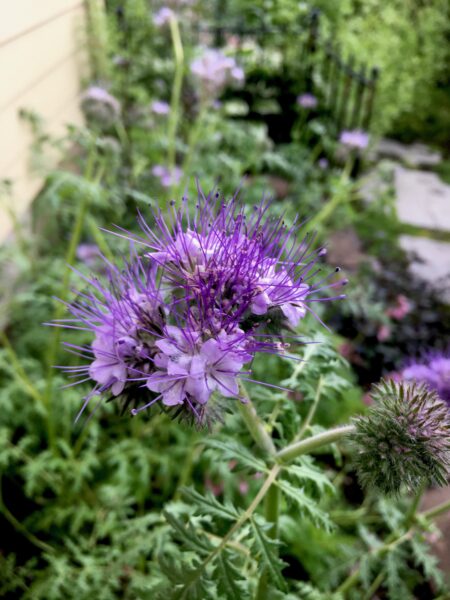
Here’s the big take away: sow lacy phacelia seeds in the Fall after cleaning up your tomato and dahlia beds for flowers the following spring – no irrigation or extra fuss needed.
That’s right, this native annual germinates with the autumn rains, grows through the cool months and blooms just as your warm season plants are starting. This kind of seasonal layering is the easiest way to extend your pollinator gardening throughout the year. And, by sowing lacy phacelia in a bed that would be bare through winter (like your dahlia or tomato bed), you’re covering the soil and protecting it from heavy winter rains and weed invasion. Win win win!
Do keep in mind that, unlike carrots, lacy phacelia wants it dark to germinate, so tuck those seeds in with a cozy compost blanket.
In Katrina’s garden, I cut the dahlias down late last October. With some extra seeds on hand, it was an easy 5 minutes of work to sow lacy phacelia as a cover crop. Now, in May, it’s blooming with its enchanting blue against the dark leaves of an early emerging dahlia from last year. I’d cleared a bit of phacelia away this spring to add some new dahlias and those are just peeking through the gaps now. By the time the dahlias are big and full, the phacelia will have completed its life cycle, feeding countless bees before its annual demise.
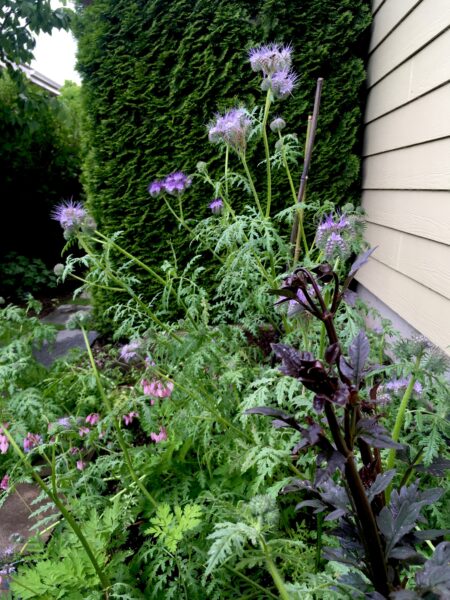
This same seasonal layering approach could work with any warm season plants: tomatoes, squash, zinnias or even in the spaces between late-to-emerge, summer flowering perennials like Helianthus ‘lemon queen’ or Hibiscus moschuetos.
Bonus tip: lacy phacelia isn’t the only pollinator magnet that can be sewn in fall. California poppies (Eschscholzia californica) and Douglas meadowfoam (Limnanthes douglasii) are two other natives that you could use in exactly the same way.
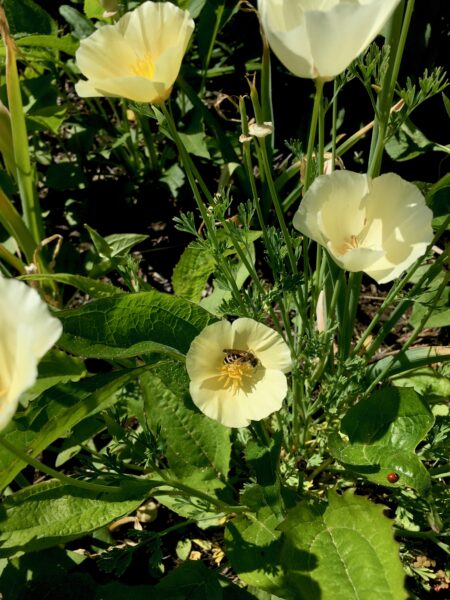
buttercream California poppy popping up with echinacea
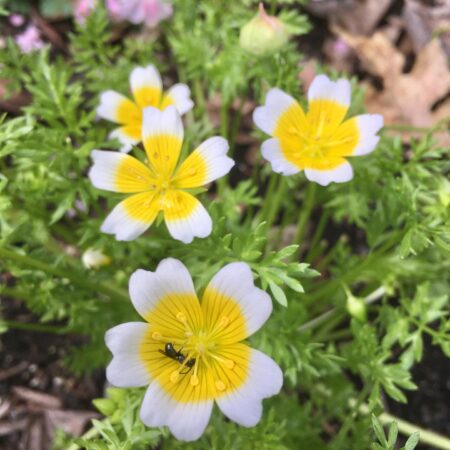
tiny native bee getting to work on the meadowfoam
Put a note on your October calendar to sow lacy phacelia seeds in your garden. This one simple task will attract more pollinating insects to your garden than purchasing the sponsored hybrid plant claiming to be “good for pollinators” or blindly adding a “variety of flower shapes.”
Where will you sew lacy phacelia this Fall? Leave a comment below to let me know.

Leslie, this is awesome! I love that you are writing this blog. This kind of not dumbed down information is exactly what we all need! Thank you!
Thank you Brent!
I am so onboard with your suggestions but where do I get these plants? Thanks so much for your blog. I really appreciate your perspective.
Hi Dana, Thanks for reading! You can get seed for lacy phacelia from a number of good sources. Northwest Meadowscapes is a great one!
Thanks for the great read, I’ve just sown Lacy Phacelia in a row yesterday next to my veg plot. Kind regards
That’s wonderful to hear! May your veg plot be blessed with great pollination.